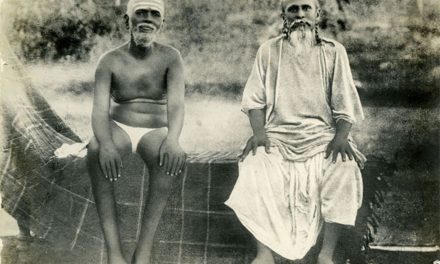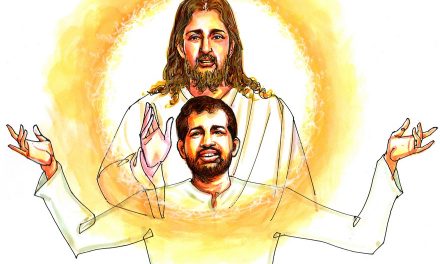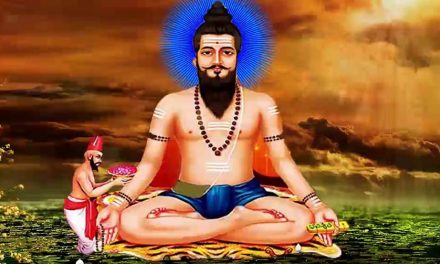Arakkhita Das (Arakshita) occupies a unique place in Orissa”s rich tradition of saint-poets. He was born into the ruling family of the big zamindari (estates) of Badakhemundi in Ganjam district of coastal Orissa towards the end of the 18th century. Various sources place his year of birth between 1780 and 1788, more likely towards the later date. He grew up in tumultuous times, when the British were finally gaining ascendancy in Orissa; and perhaps his renunciation from his privileged context took place at about the same time as the British conquest of Orissa in 1803. But he seems to have left home and taken formal sanyas (permanent renunciation of worldly life and the status of a householder) after the death of his father in a battle with the British, and his uncle”s subsequent ascent to the throne. He wandered around coastal Orissa for some time before settling on the Olasuni hill in Kendrapada district; he never left it again.
Das left behind no disciples and no sect. Very few details about his life are available. He stands at an odd angle to the spiritual tradition of Orissa, and simultaneously symbolises a bridge as well as a rupture from the tradition. On one hand, his work marks the apogee of the tradition of saint-poets whose members include such stalwarts such as Jagannatha Das (who translated the Shrimad Bhagabat Puranam into Oriya) and Balaram Das (who translated the Ramayana into Oriya). This tradition represents a synthesis of extant spiritual systems, as well as a conscious reformulation of the sacral in the idiom of the “vernacular” that parallels other so-called “bhakti” traditions elsewhere in India during in the same period. Yet perhaps the most distinctive aspect of this tradition was its absorption of bajrayana (a popular form of Tantrik Buddhism which flourished in Orissa) symbolism and “mysticism” into a predominantly Hindu formulation surrounding Lord Jagannatha (the deity at Puri, coastal Orissa), and not Hindu-Islamic syncretism as is generally formulated. Arakkhita Das” work foreshadows the later radical work of Bhima Bhoi (1855-1895), the author of texts such as Stuti Chintanani, Nirbeda sadhana and Brahma Nirupana Gita. The most prominent disciple of Mahima Gosain (the founder of the Mahima religion popular among the subaltern groups of western Orissa and Chhatishgarh), Bhoi breaks with the extant Hindu spiritual traditions of Orissa through a complete negation of the authority of the Vedas.
However, Das makes a few greater “transgressions” as well; for example, he denies the very existence of something like the transmigrating atman (soul or indestructible essence), as evidenced by this line from the translation of his work later in this essay: “once a form dissolves it never returns, there is no birth after death.” He also denies the necessity of any conventional spiritual “practice”, and posits instead the necessity of a direct and almost childlike perception into the nature of reality.
Das left behind quite a voluminous amount of poetry that is yet to be properly catalogued and published in its entirety. His most popular work is titled Mahimandala Gita (The Gita of the Earth). It is quite a remarkable text for many reasons, the most important perhaps being the fact that within it we catch glimpses of Arakkhita Das as a person grappling with the same set of mundane and yet not-so-mundane existential problems that all humans have to confront, but ultimately managing to soar above them.
For me, though, the significance of this text lies tucked within the brief confines of Chapter 66. Most intriguingly, it includes three pages written in the tradition of Oriya “prose” texts such as the Chatura Binoda, most probably written in the last quarter of the 18th century by Brajanatha Badajena (1730-1800), and the Rudra Sudhanidhi by Abadhuta Swami, written in the latter half of the 15th century.
From a vantage point within the tradition of “modern” Oriya literature of the early 21st century, these texts are not written in prose at all; they are curious hybrids, wayward mongrels, creatures of the badlands of the frontier, that defy categorisation and refuse to be slotted as either prose or poetry. But if one compares these texts with the comparatively voluminous prose produced in Oriya in the latter half of the 19th century, one is struck by the lucidity and lightness of touch of the former when compared to the rigidity and staidness of the more “modern” prose of the latter period.
This comparison has to be contextualised within a history in which the very syntax of Oriya prose was shaped by the activities of missionaries who attempted to standardise Oriya prose. The standardisation was attempted via the imitation of English models, and the process of imitation continued for quite a while. For instance, the word prabandha that in the pre-colonial period denoted a composition (sometimes in “prose” but, more often than not, in “poetry”) came to mean that most European of all prose artefacts – the essay. In fact, these linguistic efforts involved a process of translation – not only of texts themselves, such as the Bible and other works crucial to the evangelical domain, but also of literary genres, forms and syntax.
Till very recently the debates in translation studies have been framed around the questions of meaning, authenticity and fidelity, and have ignored questions of power and history in the context of colonialism. Theorists such as Tejaswini Niranjana have tried to problematise this discourse by positing translation as a political act; this is done by expanding the notion of translation to include questions of language, representation and power in a very broad sense, and by attempts at liberating the practice of translation from the fidelity/betrayal binary.
But such a reading of translation both as discourse and process is hedged from the beginning by the limited historical horizon that it chooses to work under. Translation as a practice is not a colonial/Western invention. Most modern Indian languages have had a very strong tradition of translation; in fact, it may be argued that most modern Indian languages were configured as contemporary entities through sustained acts of translation. In the case of Oriya, two texts assume salience – a translation of the Mahabharata in the second half of the 15th century by Sarala Das (the pen name of Siddheswara Parida), and a translation of the Shrimad Bhagabata Puranam by Jagannatha Das (1490-1550). The former is the first substantial literary work in the language, whereas the latter work “standardised” Oriya – it created a style so powerful, and asserted a reach so pervasive, that the language of the Bhagabata became the standard Oriya; and it so successfully appropriated a Sanskritic idiom and vocabulary in order to create a formal structure of linguistic usage, that most later writers were seduced into using it. This translation was completely in verse and can be located as poetry, whereas the translation of the Mahabharata was in a metrical form called the d”ndi brutta that, despite being a verse form, enables a text written in it to be read as either prose or poetry. Later, Balarama Das used the same metrical form to translate the Ramayana into Oriya.
Therefore, such processes of “translation” were central to the formation of Oriya as a literary language; this can perhaps be tentatively generalised for other modern South Asian languages as well. It seems to be central to what can perhaps be termed as the “translation effect” through which modern South Asian languages were standardised. This fact is glossed over in the perceptive discussion by the eminent American Sanskritist/South Asia scholar Sheldon Pollock on the formation of the “cosmopolitan vernacular” towards the middle of the second millennium of the Christian era. Pollock offers the case of Kannada, and argues that from the beginnings of the last millennium on, regional kingdoms started to claim the political place earlier occupied by supra-regional empires. Sanskrit was the language of the empires, whereas the newly emergent regional kingdoms were characterised by well-developed vernacular literatures. Following this key observation, Pollock does not further theorise the relationship between language and power. He rightly points out that current interpretations are rooted in the context of capitalist modernity, and scholars may be accused of anachronism if contemporary discursive frames are imposed upon pre-modern phenomena. Pollock also astutely debunks the hypothesis that posits a correlation between the “vernacularisation” of South Asia and the growing use of modern Indian languages by the emergent Bhakti/Sufi (popular Hindu/Muslim devotional) movements that supposedly challenged what is commonly known as Brahminism, and its fiercely entrenched liturgical and social orthodoxies.
This is also borne out by the fact that despite the importance of the saint-poets, the most voluminous and classically “literary” work (here it is pertinent to keep in mind the kavya/shastra dichotomy, texts that entertain versus texts that educate or instruct) was produced in Orissa in the pre-colonial period by the regional elites, who wrote kavyas in imitation of the Sanskrit models, yet precisely in opposition to the “Sanskrit Cosmopolis” (Pollock”s term for the manner in which Sanskrit was imbricated as a dominant aestheticpolitical language across South and South-east Asia through its association with a family of political and social practices such as temple-building, etc., for nearly 10 centuries, starting with the third century of the first millennium; the “cosmopolis” is used as a counterpoise to the concept of empire for describing certain types of socio-political formations). In a bid to outperform the virtuosity and complexity of Sanskrit kavyas, local litterateurs produced ornate pieces that often dealt with heavily eroticised themes. The prose forged in the aftermath of the colonial encounter seems to have been a reaction to this corpus – and was, therefore, perhaps more amenable to fulfilling the task imitating contemporary English prose forms and genres, rather than drawing upon the extant tradition of Oriya “prose”.
Thus, Chapter 66 of the Mahimandala Gita by Arakhitta Das lies in the twilight zone of the “modern” division between prose and poetry, and functions as an exemplar by which to challenge the boundaries of such formal categories in literature. This particular example of Oriya “prose” also lies towards the end of the tradition of which it is a part. Henceforth, we get prose that is as self-confessedly “virile” as the English models that it tried to successfully imitate. What follows is an anuvada (translation) of the three prose pages of Chapter 66. The original text is a palm-leaf manuscript; the rendition in the book I have translated from is a single extended paragraph, and I have more or less followed the sequence of the lines. I have translated the word Brahman as “that”, with italicisation and emphasis, in the interest of fluency as well as to avoid imposing the conceptual weight of monism that the word, which connotes a metaphysical absolute, is generally made to carry. This is also in consonance with the general Upanishadic practice of referring to Brahman as tat, commonly translated as “that”. I have amended the syntax in order to try and build a mantralike tonality and sustain an incantatory effect.
Anuvada of Mahimandala Gita, Chapter 66
If one sees what can/should not be seen, if one builds/lifts what can/should not be built/lifted, if one does what can/should not be done, if one eats what can/should not be eaten, if one says repeatedly what can/should not be repeatedly said, if one, therefore, masters what can/should not be mastered; if one is able to do all this, then one may know that, through the filter of one’s own experiences. Let us tell you what one does after one has known that through the filter of one’s own experiences – one does not bother about what one eats and where one sleeps; one does not bother about the eye, the nose, the face, the ears and the organs for excretion, the five aspects of the psyche and the twentyfive prakritis, the eleven indriyas, the six great enemies and the three gunas; one does not bother about sickness, one does not bother about sin, non-sin, merit, non-merit, dharma, non-dharma, heaven, hell, the auspicious, and the inauspicious, truth, non-truth, greed, nongreed, kama, non-kama, the virtuous and the non-virtuous, gain, non-gain, essence, nonessence, vikaara and non-vikaara, jaati and non-jaati, the masculine and the non-masculine, the feminine and the non-feminine, the living and the non-living, the chanted and the unchanted. Listen! Having known that through the filter of one’s own experiences, one never bothers with all these ever again. The embodied being, and the ultimate, Chandra, Surya, Brahma, Vishnu, Shiva, Indra, Sachi, Yama, Kubera, Varuna, Nairuta, Brihaspati, the ten Dikpalas, the constellations, the clouds, the heavens, the earth and the nether worlds; water, fire, air, and the sky; listen, oh mind, one never bothers with any of these. The four Vedas, Yoganta, Vedanta, Siddhanta, Naganta; listen, O mind, one never practices any of these. Only if one knows that one does not bother with chanting, contemplation, worship, reflection, meditation, mantras, yogasutras, pilgrimage, austerities, and fasting. One does not bother with the numerous places of pilgrimage, the numerous fasts, the numerous styles of yoga, knowledge, meditations, devotions, contemplations, chantings, offerings, mantras, markings, substances, gods, chandis, ghosts and witches; listen, oh mind, one does not practice anything related to any of them, one does not fear them nor does one worship them; one sees them all as equals, and realises that there is nothing in the world apart from me; I am spread throughout the world; I am that; realising thus, one sees all as equal, the numerous trees, flowers, fruit, soils, stones, birds, animals, insects, fish, flies, horseflies, cows, buffaloes, boar, deer, horses, elephants, goats, sheep, pigs, cats, dogs; the many forms of rats, snakes, smaller animals, ants, termites, lizards, scorpions, humans, gods, rakshasas, weapons, texts, Puranas, Gitas, musical instruments, debates, Vedas, jyotishas, indulgences, maladies, dances, songs, musical instruments, clothes, cuisines, the six rasas, the eight metals, the nine gems, the six seasons, the static and the dynamic; the ones that fly and the ones that swim, the numerous varieties of insects and flies, all the fifty-six crore species of creatures from all the four directions; one sees them as equals and in doing so, one sees them as that. If one finds such a person, then one can rest assured that such a person abides in that. Such a one does not drown in water; even Agni does not burn him, the strongest of the winds do not make him fly, swords do not hurt him; even if the earth decays, his being does not decay, it becomes the heavens, the earth, the nether worlds, it seeps into the fifty-six crore species of creatures and can attain varied forms intermittently; the seven worlds become like grass to him; Brahma, Indra, Chandra, Surya, none equal him, the thirty-three crore gods, humans, rakshasas, the earth, water, Teja, Vayu, Akash, nothing equals his essence. Therefore, O mind, listen to the grace of devotion; one who has an empty mind knows that, knows nothing apart from that, knows the world to be that, wanders alone and shuns company, has that for company, feels only that, has no fears and knows nothing apart from that, so that one knows only that and doing so meditates in that, sleeps in that, sings in that; therefore, O mind, listen to what you wanted to hear. Such a person knows that which is singular in form, how can anyone else know that; in fact, no one can know that, as that does not have colour, eyes, face, ears, nose, eyes, hands, legs, heart, belly, waist, back, head or skin, form, marks, blood, flesh; being beyond sight, speech, colour, air, form and repetition; listen, oh mind, no one sees that without devotion. All the jivas are eroded out of that and on death go back to rest in that. In death lies birth; now let us explicate with an analogy; if we take a pot with some sweetened water in it to a pond, and then empty the pot into the pond, and fill the pot with water from the pond, then does the water in the pot taste sweet? Likewise, once a form dissolves it never returns; there is no birth after death, once this body goes, it is never to be had again; therefore only if you abide in the body, then you can know that which is singular in form. Listen, O mind, feel everything with equanimity and abide in the singular in form without any vikaara, for that is unrecognisable for a mind with an iota of vikaara…














I really like devine India.
Thanks for the translation. Carries the same meaning as Nirvana Shatakam by Adi Shankaraachaarya.
Namaskar ,
if you will be adding new saints to your lists please include the following :
SHIVA YOGINI AMMA…….PARAMHAMSA YOGESHWARANANDA(YOGA NIKETAN),SRI SRI ANANDAMURTI…..MAHAVATAR BABAJI…..
YOGI HARI(GUYANESE)……